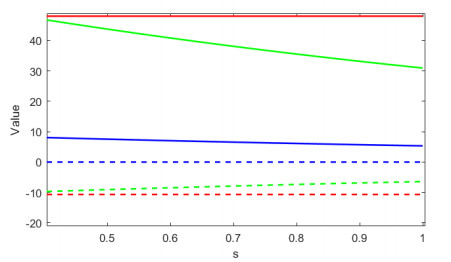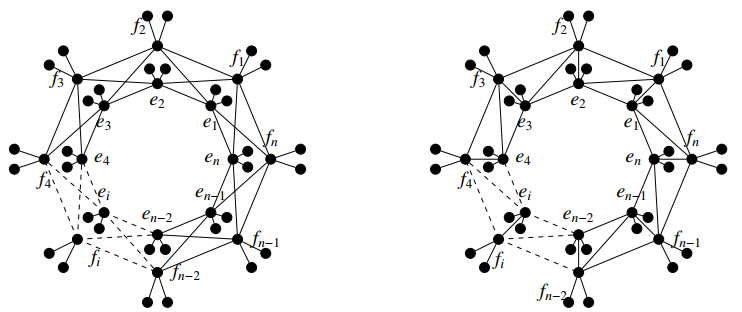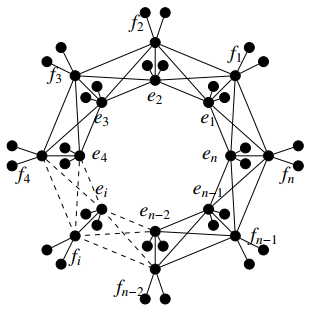1.
Introduction
The classical Hermite-Hadamard (H-H) inequality, serving as a litmus test for convexity, formally establishes that if the function F:[ℑ1,ℑ2]→R is a convex function satisfying the essential containment relationship between its midpoint value and integral mean. Specifically, the following inequalities are satisfied:
Convexity inequalities have numerous applications in the study of different models from real-world applications [1,2]. Because the H-H inequality is of great significance in convex analysis, it is widely applied in various fields such as integral inequalities, information theory, and optimization theory. In recent years, it has been extended and generalized through various forms of convexity, such as log-convexity [3,4], harmonic convexity [5,6], h-convexity [7,8,9], convexity in q-calculus [10,11,12] and especially s-convexity [13]. Since 1994, s-convexity has been a significant development and widespread application and various generalizations and results regarding H-H inequalities related to s-convex mappings have been established in [14,15,16].
From another perspective, interval analysis provides an effective numerical tool for solving uncertain and nonlinear problems. Since the publication of the first monograph in 1966 [17], it has evolved into a distinct branch of mathematics, with applications spanning data mining, machine learning, and various other fields. A key focus has been interval-valued (IV) function inequalities. Recently, based on interval calculus and generalized convexity, some authors like Ali et al. [18,19,20], Budak et al. [21,22], Costa et al. [23,24,25], Du et al. [26,27], Khan et al.[28,29], Sarikaya et al. [30,31,32], and Zhao et al. [33,34,35] established the interval versions of the Chebyshev's inequality, Jensen's inequality, and H-H inequality. Furthermore, with the successive introduction of the bilateral Riemann-Liouville (R-L) fractional integral operators (left-hand and right-hand variants) for IV functions, the results related to inequalities for IV functions are more extensive and profound [36,37]. Especially, in 2023, Budak et al. [38] introduced a novel generalized integral to demonstrate the generalized H-H-type inclusion of IV convex functions.
Motivated by the above-mentioned literature, we have established some novel interval forms of H-H inequalities by using generalized fractional integral operators and combining them with IV s-convex functions. The classical convexity theory is extended to the generalized s-convex framework, some interesting theorems are proved, and the exact inequality representation of the product of two s-convex functions is given. Our findings not only extend the main conclusions in [36,38,39], but also provide new insights for the study of IV inequalities.
The organization of this work is outlined below: Section 2 introduces essential background concepts, while Section 3 establishes a series of H-H-type inequalities for IV s-convex mappings using generalized fractional integral operators. Section 4 gives the conclusion.
2.
Preliminaries
Let A denote a compact real interval, mathematically expressed as
where A_,¯A∈R satisfy A_≤¯A. If A_=¯A, the interval becomes degenerate. The intervals discussed in this paper are all non-degenerate intervals. An interval [A] is termed positive when A_>0, and negative if ¯A<0. The sets R−I, R+I, and RI, respectively, denote all negative, positive, and arbitrary real-valued intervals. Additionally, we adopt the partial ordering "⊇" defined by
For η∈R and A∈RI, then
For arbitrary A,B∈RI, the following four arithmetic operations are given:
For additional information on interval arithmetic, refer to [40].
Definition 2.1. [13] A function F:[ℑ1,ℑ2]→R is classified as s-convex if it satisfies the convexity condition:
for all ℏ1,ℏ2∈[ℑ1,ℑ2] and ι∈[0,1] with s∈(0,1].
In [41], Breckner introduced the IV s-convex functions.
Definition 2.2. [41] F:[ℑ1,ℑ2]→R+I is defined as an IV s-convex function if
for ℏ1,ℏ2∈[ℑ1,ℑ2] and ι∈[0,1].
Consider F:[ℑ1,ℑ2]→R+I, we define ∫ℑ2ℑ1F(ι)dι by
and say that the function F is interval Lebesgue integrable on [ℑ1,ℑ2] (or that F∈IL[ℑ1,ℑ2]).
Definition 2.3. [42] Let F∈L[ℑ1,ℑ2]. The bilateral R-L fractional integral operators, namely the left-sided Jαℑ1+F and the right-sided Jαℑ2−F, are defined as
and
respectively, where α>0, ℑ1≥0, J0ℑ1+F(σ)=J0ℑ2−F(σ)=F(σ) and Γ(α) is the Gamma function.
The H-H inequality in the form of R-L fractional integrals was proved by Sarikaya et al. in [32] as follows:
Theorem 2.4. Let F∈L[ℑ1,ℑ2] be a mapping from [ℑ1,ℑ2] to R+. If F satisfies the convexity condition, then
with α>0.
Definition 2.5. [36,37] Let F:[ℑ1,ℑ2]→R+I. The IV R-L fractional integral operators, including both left-sided and right-sided variants, are defined as follows:
and
respectively. Here, Iαℑ1+F(σ)=[Jαℑ1+F_(σ),Jαℑ1+¯F(σ)], and α>0.
In [36], Budak et al. gave the fractional H-H inequality for IV convex functions as follows:
Theorem 2.6. Let F:[ℑ1,ℑ2]→R+I, and α>0. If F is an IV convex function, then
Definition 2.7. [31] Let φ:[ℑ1,ℑ2]→R+ be a monotonically increasing mapping, and suppose F,φ∈L[ℑ1,ℑ2]. The generalized R-L fractional integral operators Jα,kℑ1+,φF and Jα,kℑ2−,φF are defined by
and
respectively, where k∈N∪{0}, α>0, and ℑ1≥0.
In 2023, Budak et al. introduced the generalized fractional integral for IV function as follows:
Definition 2.8. [38] Let φ:[ℑ1,ℑ2]→R+ be a monotonically increasing function, and F:[ℑ1,ℑ2]→R+I. The generalized R-L fractional integrals Iα,kℑ1+,φF and Iα,kℑ2−,φF of interval-valued functions are defined by
and
respectively, where α>0, ℑ1≥0 and k∈N∪{0}.
The families of all functions that are Riemann integrable and interval Riemann integrable over the closed interval [ℑ1,ℑ2] are respectively represented by the notations R[ℑ1,ℑ2] and IR[ℑ1,ℑ2].
Theorem 2.9. [38] Suppose F∈IR[ℑ1,ℑ2], φ:[ℑ1,ℑ2]→R is a monotonically increasing function on (ℑ1,ℑ2) with φ∈L[ℑ1,ℑ2]. Letting Φ(ι)=F(ι)+F(ℑ1+ℑ2−ι), then Φ∈IR[ℑ1,ℑ2], and we have
where α>0 and k∈N∪{0}.
3.
Main results
Let Φ(ϖ)=F(ϖ)+F(ℑ1+ℑ2−ϖ) and Λ(ϖ)=G(ϖ)+G(ℑ1+ℑ2−ϖ) for ϖ∈[ℑ1,ℑ2]. It is straightforward to demonstrate that if F,G∈IR[ℑ1,ℑ2], then Φ(ϖ),Λ(ϖ)∈IR[ℑ1,ℑ2].
Theorem 3.1. Let F:[ℑ1,ℑ2]→R+I, F∈IR[ℑ1,ℑ2], and φ:[ℑ1,ℑ2]→R+ be a monotonically increasing function. If F is an IV s-convex function, then
where α>0 and k∈N∪{0}.
Proof. By the assumption, we have
Letting ℏ1=ιℑ1+(1−ι)ℑ2, ℏ2=(1−ι)ℑ1+ιℑ2 for ι∈[0,1], we obtain
Then, multiplying the two sides of (3.3) by ια−1(φ(ℑ2)−φ(ιℑ1+(1−ι)ℑ2))k and integrating on [0, 1], we obtain
Letting y=ιℑ1+(1−ιℑ2), we have
That is,
By multiplying the two sides of (3.3) by ια−1(φ((1−ι)ℑ1+ιℑ2)−φ(ℑ1))k and integrating on [0, 1], we obtain
Letting y=(1−ι)ℑ1+ιℑ2, we have
Combining with conclusions (3.4) and (3.5), we obtain
According to (2.2), we have
That is,
Multiplying the two sides of (3.6) by ια−1(φ(ℑ2)−φ(ιℑ1+(1−ι)ℑ2))k and integrating on [0, 1], we obtain
Letting y=ιℑ1+(1−ι)ℑ2, we have
That is,
Similarly, multiplying the two sides of (3.6) by ια−1(φ((1−ι)ℑ1+ιℑ2)−φ(ℑ1))k and integrating on [0, 1], let y=ιℑ2+(1−ι)ℑ1, we have
Then, we obtain
By (3.7) and (3.8), we have
Hence, Theorem 3.1 is verified.
□
Corollary 3.2. If φ(ι)=ι−ω for ω∈R and s=1, then
Remark 3.3. If s=1, Theorem 3.1 is reduced to Theorem 4.1 obtained by Budak et al. in[38].
Remark 3.4. If k=0, then
Remark 3.5. If s=1 and k=0, then Theorem 3.1 simplifies to Theorem 3.2 as presented by Budak et al. in [36].
Example 3.6. Consider F:[0,2]→R+I, where F(x)=[2x2−4,−8x2+20x−3], φ(ι)=ι−ω for ω∈R, α=2,s=1, and k=1. Then we have
and
Then, we obtain
The graphical representation (Figure 1) confirms the results. $
Theorem 3.7. Assuming that the conditions of Theorem 3.1 are met, then
where α>0 and k∈N∪{0}.
Proof. First, consider ℏ1=12ιℑ1+12(2−ι)ℑ2 and ℏ2=12ιℑ2+12(2−ι)ℑ1 for ι∈[0,1] in the inclusion (3.2). Then,
Then, multiplying the two sides of (3.10) by ια−1(φ(ℑ2)−φ(12ιℑ1+12(2−ι)ℑ2))k and integrating on [0, 1], we obtain
Letting y=12ιℑ1+12(2−ι)ℑ2, we have
that is,
Similarly, multiplying the two sides of (3.10) by ια−1(φ(12(2−ι)ℑ1+12ιℑ2)−φ(ℑ1))k and integrating on [0, 1], we have
Letting y=12(2−ι)ℑ1+12ιℑ2, we have
that is,
By (3.11) and (3.12), we obtain the result. □
Corollary 3.8. If φ(ι)=ι−ω for ω∈R and s=1, then
Remark 3.9. If s=1, then Theorem 3.7 simplifies to Theorem 4.4 given by Budak et al. in[38].
Remark 3.10. If k=0, then
Remark 3.11. If s=1 and k=0, then Theorem 3.7 which has been obtained by Zhao et al. in [39].
Example 3.12. Consider F:[0,1]→R+I, where F(x)=[x2,5−(12)x], φ(ι)=ι−ω for ω∈R, α=2,s=1, and k=1. Then we have
and
Then, we obtain
Theorem 3.13. Given that the assumptions of Theorem 3.1 hold, we can obtain
for α>0 and k∈N∪{0}.
Proof. Considering ℏ1=12(1+ι)ℑ1+12(1−ι)ℑ2 and ℏ1=12(1−ι)ℑ1+12(1+ι)ℑ2 for ι∈[0,1] in the inclusion (3.2). Then we obtain
Then, multiplying two sides of (3.14) by
and integrating on [0, 1], we obtain
Letting z=12(1+ι)ℑ1+12(1−ι)ℑ2, we have
that is,
Multiplying two sides of (3.14) by
and integrating on [0, 1], we obtain
Letting z=12(1−ι)ℑ1+12(1+ι)ℑ2, we obtain
Adding the inclusion (3.15) to (3.16), we complete the proof. □
Corollary 3.14. If φ(ι)=ι−ω for ω∈R and s=1, then
Remark 3.15. If s=1, Theorem 3.13 simplifies to Theorem 4.7 presented by Budak et al. in[38].
Remark 3.16. If s=1 and k=0, then
which has been obtained by Zhao et al. in [39].
Example 3.17. Consider F:[0,2]→R+I, where F(x)=[x2,−x2+8], φ(ι)=ι−ω for ω∈R, α=2,s=1, and k=1. Then we have
and
Then, we obtain
Theorem 3.18. Let F,G:[ℑ1,ℑ2]→R+I, s1,s2∈(0,1], and φ:[ℑ1,ℑ2]→R be a monotonically increasing function. If F and G are both IV s-convex functions, then
where
and
Proof. By hypothesis, then
Considering ℏ1=ιℑ1+(1−ιℑ2) and ℏ2=(1−ι)ℑ1+ιℑ2, we obtain
By multiplying two sides of (3.18) by ια−1(φ(ℑ2)−φ(ιℑ1+(1−ι)ℑ2))k and integrating on [0, 1], we obtain
Letting y=ιℑ1+(1−ι)ℑ2, then
that is,
By multiplying two sides of (3.18) by ια−1(φ((1−ι)ℑ1+ιℑ2)−φ(ℑ1))k and integrating on [0, 1], we have
Letting y=(1−ι)ℑ1+ιℑ2, that is,
Adding the inclusion (3.19) and (3.20), we obtained the desired result. □
Example 3.19. Assume F,G:[0,2]→R+I, where F(x)=[x2,−x2+10] and
respectively. Let φ(ι)=ι−ω for ω∈R, α=2,k=1, and s=1. Then we have
and
and
Then, we obtain
Analogously, we can derive the subsequent results.
Theorem 3.20. Assuming that the conditions of Theorem 3.18 hold, we consequently obtain
Theorem 3.21. Assuming that the conditions of Theorem 3.18 hold, we obtain
4.
Conclusions
This study derives novel H-H-type inequalities through generalized fractional integrals applied to IV s-convex functions. These not only generalize but also refine the previously proposed inequalities established by Budak et al. and provide a foundation for further exploration of generalized convexity and IV estimation. The developed techniques offer new tools for uncertainty quantification in convex optimization problems with imprecise measurements. Future research directions include:
(1) Develop new interval H-H inequalities based on more general convexity.
(2) Extension to IV quasi-convex functions using variable-order fractional operators.
(3) Applications in robust portfolio optimization with IV risk measures.
Author contributions
G. Deng and D. Zhao: Conceptualization, Methodology, Formal analysis; S. Etemad: Conceptualization, Software, Formal analysis, Investigation, Writing–original draft preparation; G. Deng: Writing–original draft preparation; D. Zhao: Validation, Investigation, Supervision, Project administration, Writing–review and editing; J. Tariboon: Validation, Formal analysis, Project administration, Writing–review and editing. All authors read and approved the final manuscript.
Use of Generative-AI tools declaration
The authors declare they have not used Artificial Intelligence (AI) tools in the creation of this article.
Acknowledgments
This research was funded by the National Science, Research and Innovation Fund (NSRF) and King Mongkut's University of Technology North Bangkok, under Contract No. KMUTNB-FF-68-B-04, and the Foundation of Hubei Normal University (2024Z022).
Conflict of interest
The authors declare no conflict of interest.










 DownLoad:
DownLoad:








